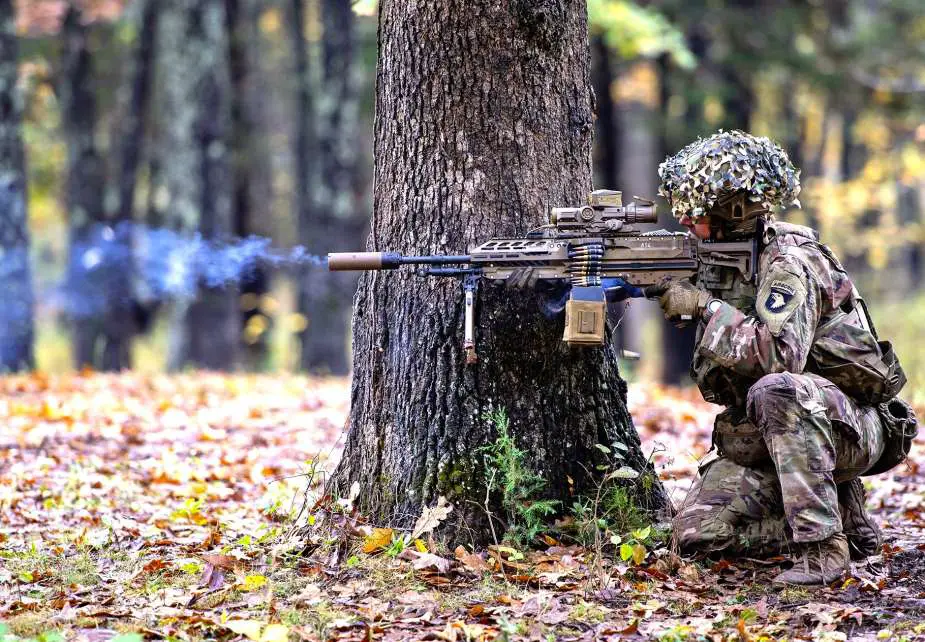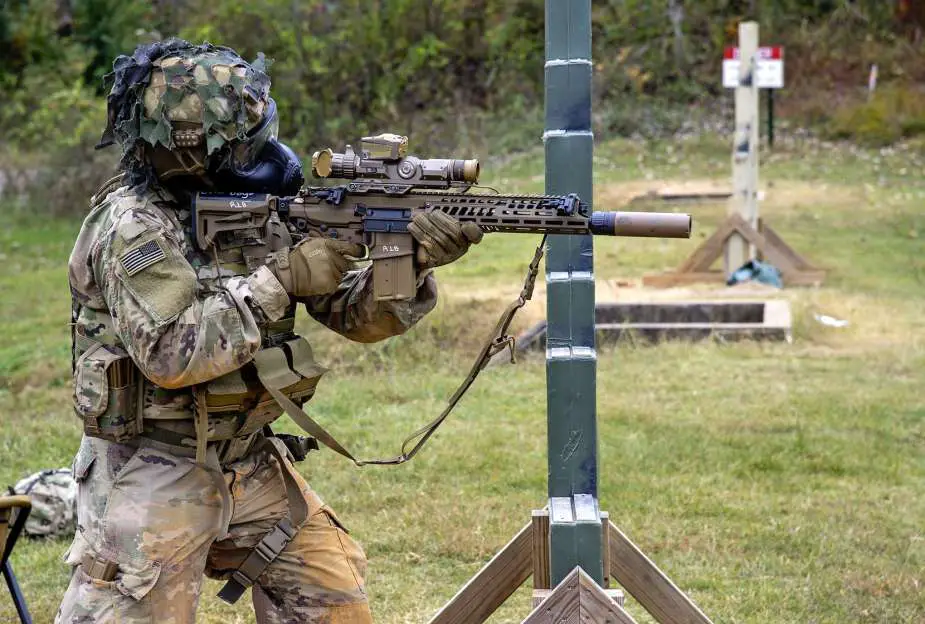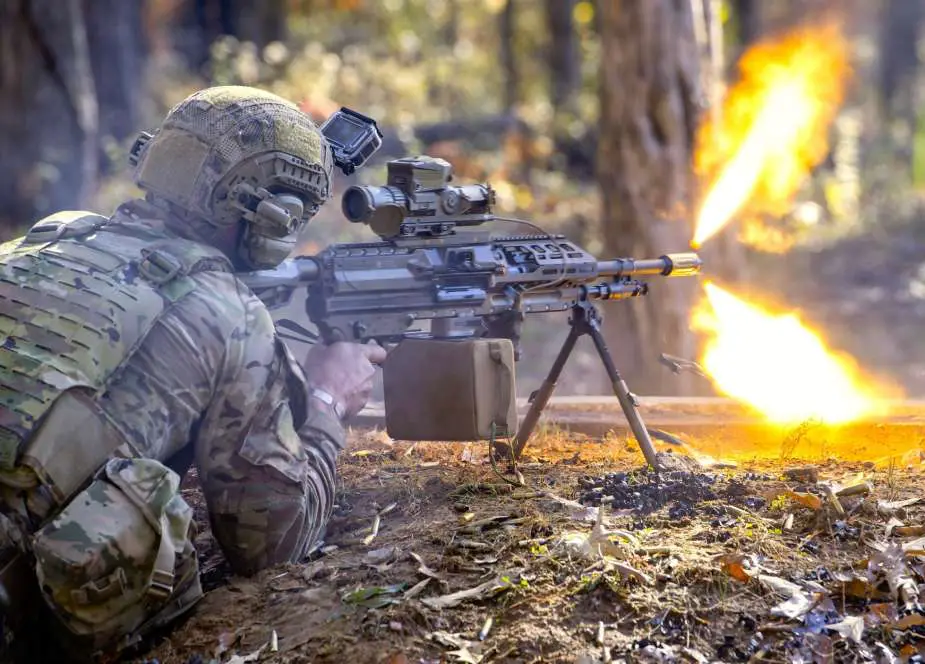Breaking news
US paratroopers and Rangers test Next Generation Squad Weapons.
Screaming Eagle Division soldiers at Fort Campbell just completed training and testing the U.S. Army’s 6.8mm family of Next Generation Squad Weapon-Rifle (NGSW-R), NGSW-Automatic Rifle (AR) and the NGSW-Fire Control (FC) systems. Maj. Rodrick A. Polk, test officer, Maneuver Test Directorate, U.S. Army Operational Test Command, reports.
Follow Army Recognition on Google News at this link

An infantryman with the 2nd Battalion, 502nd Infantry Regiment (Strike Force), 2nd Brigade (Strike), 101st Airborne Division (Air Assault) (Screaming Eagles), fires the Next Generation Squad Weapon-Automatic Rifle (NGSW-R) at Fort Campbell, Kentucky (Picture source: U.S. Army/Mark Scovell)
Troops of Alpha Company, 2nd Battalion, 502nd Infantry Regiment, 2nd Brigade, 101st Airborne Division (Air Assault) and members of 1st Battalion, 75th Ranger Regiment, undertook New Equipment Training on the NGSW. "The New Equipment Training gave the soldiers a good base before coming out and using the NGSWs,” said Infantryman Sgt. Jack Scott, a team leader in Alpha Company.
Their training covered the similarities and differences between the new weapons and the legacy 5.56mm M4A1 Carbine and M249 Squad Automatic Weapon systems, focusing on enhanced lethality. “We did a lot of training with both static and maneuver ranges, so the product of Soldier you get now, during the live fire, is high quality due to all of that training,” added Scott.
Once complete with new equipment training, soldiers tested the NGSW in a Limited User Test, or LUT, in a crawl-walk-run method to ensure all operational data is collected on the weapon, as well as user integration with the new equipment.
Alpha Company and 1st Battalion, 75th Ranger Regiment initially conducted static qualification and variable distance ranges with legacy weapon systems and NGSW, to compare the performance of both and give Soldiers repetitions and familiarity with the NGSW. Alpha Company 1st Sgt. Justin Babb appreciated the benefits of participating in an operational test and the opportunity for his junior Soldier’s feedback to contribute and impact Army modernization. “The candid feedback that the Soldiers and NCOs provided during focus groups and surveys will provide the Army with perspective from the lowest level of the user who will use the system,” said Babb.

An infantryman with 2nd Battalion, 502nd Infantry Regiment (Strike Force), 2nd Brigade (Strike), 101st Airborne Division (Air Assault), firing NGSW-R during CBRN defense day qualification (Picture source: U.S. Army/Mark Scovell)
Major differences between the legacy M4, M249 systems and the NGSWs were immediately noticeable by the soldiers. Spec. Maximiliano Arguindegui, an automatic rifleman with the 1/75th Ranger Regiment, said, "Overall, I feel faster with the M249, but I prefer the NGSW-AR because it makes me more lethal". Scott added, "Stopping power with the 6.8 round is a big improvement compared to the M4 and M249 and having the ability to use with or without the suppressor is a huge feature for the support by fire element."
Leaders of Alpha Company also said participating in a test with the Operational Test Command enabled them to get after their internal readiness. Alpha Company Commander, Capt. Jordan Mares, said: “Being a part of the NGSW test supported our company readiness. The LUT gave us opportunities to hone our craft, practice lessons learned with feedback from subject-matter experts, and the ability to conduct a lot of repetitions to practice small unit tactics."
Staff Sgt. Ivan Alvarez, a Squad Leader with Alpha Company, was initially skeptical of the NGSW: "When we first started the LUT, I was very against the NGSW-R,” he said. “I'm used to the M4 — it's lighter — I'm used to the recoil, the engagements, everything the M4 has to offer. But, as we went through the LUT with the NGSW-R, I can see the capabilities that it brings to an infantryman, especially at a longer distance."
Alvarez also said testing the new weapons gave his squad added training opportunities: "We got after a lot of training that we would normally have to wait months to set up and accomplish,” he said. “We were able to get more marksmanship time, more range time, and were able to train under various environmental conditions."
Another squad leader with the Rangers provided his observations on the training benefit while participating in an operational test: “We were able to get reps in on a new weapon system as well as our legacy equipment,” said Sgt. Joseph Martin. “We were able to train on many basic things that we want to train on every year, but condensed to get more repetitions, as well as live fire iterations for our younger, inexperienced Soldiers.”

A Ranger with the 1st Battalion, 75th Ranger Regiment, engages targets during squad live fire (blank iteration), while operationally testing at Fort Campbell, Kentucky (Picture source: U.S. Army/Mark Scovell)
Defense News December 2023




























